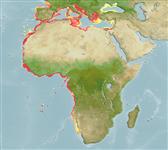Élasmobranches (requins et raies) (sharks and rays) >
Squatiniformes (Angel sharks) >
Squatinidae (Angel sharks)
Etymology: Squatina: Latin for skate, which angel sharks superficially resemble, presumably tautonymous with Squalus squatina Linnaeus 1758 (no species mentioned). (See ETYFish); oculata: Latin for eyed or having eyes, referring to the symmetrical ocelli seen on some specimens. (See ETYFish).
More on author: Bonaparte.
Environment: milieu / climate zone / depth range / distribution range
Écologie
marin démersal; profondeur 5 - 500 m (Ref. 10719), usually 50 - 100 m (Ref. 247). Subtropical; 47°N - 29°S, 17°W - 37°E
Eastern Atlantic: Mediterranean and Morocco to Angola.
Taille / Poids / Âge
Maturity: Lm ? range ? - ? cm
Max length : 160 cm TL mâle / non sexé; (Ref. 247); common length : 120 cm TL mâle / non sexé; (Ref. )
Description synthétique
Clés d'identification | Morphologie | Morphométrie
Épines dorsales (Total) : 0. An angelshark with large thorns on snout and above eyes but not on midback, weakly bifurcated nasal barbels and weakly fringed anterior nasal flaps, the first dorsal-fin origin usually well behind the rear tips of pelvic fin, and prominent white spots on body (Ref. 247)
Found on sand and mud bottom (Ref. 26999) of continental shelves and upper slopes (Ref. 247). Mostly between 50 and 100 m but deeper in the tropics (Ref. 247). Feeds on small fishes (Ref. 247). Ovoviviparous (Ref. 50449). Utilized fresh and dried salted for human consumption; liver oil and hide also used (Ref. 247).
Life cycle and mating behavior
Maturities | Reproduction | Spawnings | Egg(s) | Fecundities | Larves
Ovoviviparous, embryos feed solely on yolk (Ref. 50449). Size at birth about 24 to 27 cm TL (Ref. 247).
Compagno, L.J.V., 1984. FAO Species Catalogue. Vol. 4. Sharks of the world. An annotated and illustrated catalogue of shark species known to date. Part 1 - Hexanchiformes to Lamniformes. FAO Fish. Synop. 125(4/1):1-249. Rome, FAO. (Ref. 247)
Statut dans la liste rouge de l'IUCN (Ref. 130435)
Menace pour l'homme
Traumatogenic
Utilisations par l'homme
Pêcheries: intérêt commercial mineur
Outils
Articles particuliers
Télécharger en XML
Sources Internet
Estimates based on models
Preferred temperature (Ref.
123201): 13 - 19.3, mean 15.3 °C (based on 133 cells).
Phylogenetic diversity index (Ref.
82804): PD
50 = 0.5000 [Uniqueness, from 0.5 = low to 2.0 = high].
Bayesian length-weight: a=0.00550 (0.00303 - 0.00997), b=3.06 (2.90 - 3.22), in cm total length, based on LWR estimates for this species & Genus-body shape (Ref.
93245).
Niveau trophique (Ref.
69278): 4.0 ±0.5 se; based on diet studies.
Résilience (Ref.
120179): Faible, temps minimum de doublement de population : 4,5 à 14 années (Fec assumed to be <100).
Fishing Vulnerability (Ref.
59153): Very high vulnerability (90 of 100).
Nutrients (Ref.
124155): Calcium = 16.4 [3.7, 79.5] mg/100g; Iron = 0.706 [0.185, 2.111] mg/100g; Protein = 19.2 [17.1, 21.1] %; Omega3 = 0.237 [0.112, 0.507] g/100g; Selenium = 36 [11, 102] μg/100g; VitaminA = 9.75 [3.35, 29.81] μg/100g; Zinc = 0.442 [0.216, 0.817] mg/100g (wet weight);
